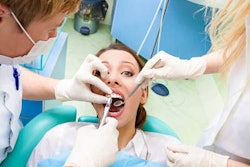
Michigan is on the fence, while Georgia is adamantly opposed.
That in a nutshell sums up the positions of two state dental associations on the role midlevel providers should or shouldn't play in improving access to care for underserved populations.
In a white paper released in June, "Oral Health Status, Access to and Utilization of Oral Health Care Services," the Georgia Dental Association (GDA) said that some proposals for midlevel providers may result from frustrations over Medicaid cuts and the belief that "some care is better than no care."
“We need to be open and willing to try these new models.”
— Frank Catalanotto, D.M.D., University
of Florida
"While these groups may be well intentioned, their solution is not based on science or data that support adding midlevel providers to the dental workforce actually improves access or lowers the cost of care," stated the GDA, declaring that it will "only create a two-tiered delivery system."
Meanwhile, in a report issued last week, "A United Voice for Oral Health: Final Report and Recommendations from the Michigan Access to Oral Health Care Work Group," the Michigan Dental Association (MDA) took the position that while midlevel providers might be able to expand access to care for certain populations, the idea remains "untested."
"To date, Michigan has not opted to authorize an alternative dental provider, although it has authorized expanded practice for dental hygienists," the report stated. "If the authorization of alternative dental providers is to be considered in Michigan, studies of their impact on the oral health of the underserved in other states will prove useful. Michigan can learn from the results of other states that have already authorized alternative providers."
The New Zealand model
The dental therapist model began in the 1920s in New Zealand and is now well established in many developed countries, including the U.K., Australia, and the Netherlands. Decades of research have shown that the preventive and basic dental repair services provided by dental therapists are safe, acceptable to the public, and cost-effective, according to a 2009 report by the W.K. Kellogg Foundation.
In 2006, the New Zealand Ministry of Health released a report outlining the country's vision for improving oral health. Among other things, the report recommends some changes to the current workforce model and suggests the need for a strategy to increase the recruitment of Pacific dental therapists. It also concludes that "dental therapists will continue to be the core clinical workforce in community oral health services, and in other services providing oral healthcare to children up to the age of 18."
But the GDA claims that New Zealand's strategy has not solved access-to-care issues nor improved oral health in the country. And the GDA report exhorts Georgians not to "step backward and expose patients to a lesser standard of care that has not worked in other countries."
In contrast, Martin Lee, B.D.S., a public health specialist who runs the Community Dental Service on South Island, New Zealand, wrote in a University of Pittsburgh dental public health online forum that dental therapists are "technically proficient and caring oral health professionals whose skills are well matched to the work they are asked to carry out. Dental therapists are also cost-effective: Once all our redevelopment work is finished, we estimate that the annual cost for our service will be NZ$130 per child."
The New Zealand program is being restructured because health officials noticed an increase in caries among young children, particularly at 5 years old, Dr. Lee said. The program was then adjusted to start checking on children at a younger age, between 12 and 15 months old. The result saw an improvement among 5-year-old children, from 50% caries-free in 2005 to 65% in 2009, he said.
Opposing views
|
Some recommendations from GDA access-to-care report
|
But GDA President Jay Harrington, D.D.S., has a different interpretation of New Zealand's decision to restructure its program.
"Our research shows that dental therapists are undereducated or less educated, and the intention of creating these types of programs is to provide care to those that are underserved and disadvantaged, a population that sometimes has more severe medical and dental issues," he said in an interview with DrBicuspid.com. "To put someone who is less trained in that situation could lead to a two-tiered system."
GDA Executive Director Martha S. Phillips stressed that the GDA report was not developed to debate dental health aide therapists (DHATs) but to look at Georgia's specific needs and how to improve access and utilization.
"We contend that merely creating different types of lesser educated DHATs has not proven to be effective," she told DrBicuspid.com. "New Zealand has changed its whole way of delivering care. If DHATs alone had solved their problem, there would be no need for restructuring."
But the GDA paper misrepresents the achievements of dental therapists, according to Jay Friedman, D.D.S., M.P.H.
"The New Zealand dental therapist program provided access to dental care for over 95% of the school-aged population and reduced permanent tooth loss to virtually zero, which has been well documented," he wrote on the University of Pittsburgh dental public health forum. "Far from diminishing the remarkable accomplishments of dental therapists, their role in providing oral healthcare to the [New Zealand] population is being expanded."
Their effectiveness has been well documented in many countries, Dr. Friedman said in an interview with DrBicuspid.com. In fact, he claims that midlevel providers actually receive more hours of training in their programs, most of which emphasize fillings and crowns in pediatric dentistry, than dental students, who have a lot more material to learn.
"They are very well trained within the parameters of their function," Dr. Friedman asserted. While little data is available regarding midlevel providers treating adults, "we sure as hell can prove the effectiveness of dental therapists treating children," he said.
Frank Catalanotto, D.M.D., a professor and chairman of the department of community dentistry and behavioral science at the University of Florida, echoed Dr. Friedman's sentiments, calling the GDA's stand on midlevel providers a "misguided interpretation of what [midlevel providers] can do to help improve access."
But MDA Director Gary Jeffers, D.M.D., M.S., an associate professor at the University of Detroit Mercy School of Dentistry, told DrBicuspid.com there is scant verified documentation to prove that assessment.
"We have not seen any published data showing their effectiveness. Right now it's a lot of anecdotal information," Dr. Jeffers said. "The ADA is very good about collecting data, and the data is just not there."
Other states considering options
|
Some recommendations from MDA access-to-care report
|
Dr. Catalanotto told DrBicuspid.com that he was impressed by Michigan's policy statement. "I got the impression that Michigan is at least open-minded and willing to hear what data might be available, which is a positive thing," he said.
Greater utilization of the midlevel provider model, especially for children, would go a long way in addressing the pediatric caries epidemic in the U.S., he added.
"They have a track record of safety, it is efficacious, and it does get care to people," he said. "I think we need to be open and willing to try these new models because there is evidence they actually work."
Minnesota is the only state in the U.S. that has formally adopted a midlevel provider model, but at least eight states, including Washington, Connecticut, and Maine, are now considering some sort of similar model, Dr. Catalanotto said.
Dr. Friedman is hopeful that midlevel providers will become an accepted way to expand access to dental care, especially during shrinking government programs and funding cuts resulting from the ongoing recession.
"There is a major development taking place within dental associations now that will at least look at and consider the possibility," he said. "Attitudes are changing, but there's still a very hard-core opposition."
Copyright © 2010 DrBicuspid.com



















